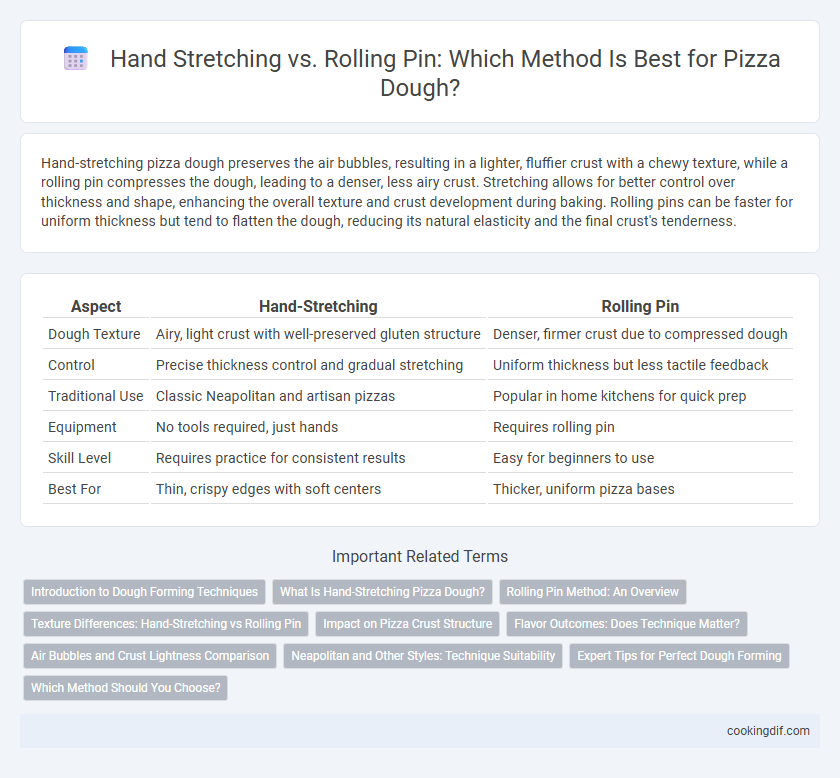Hand-stretching pizza dough preserves the air bubbles, resulting in a lighter, fluffier crust with a chewy texture, while a rolling pin compresses the dough, leading to a denser, less airy crust. Stretching allows for better control over thickness and shape, enhancing the overall texture and crust development during baking. Rolling pins can be faster for uniform thickness but tend to flatten the dough, reducing its natural elasticity and the final crust's tenderness.
Table of Comparison
| Aspect | Hand-Stretching | Rolling Pin |
|---|---|---|
| Dough Texture | Airy, light crust with well-preserved gluten structure | Denser, firmer crust due to compressed dough |
| Control | Precise thickness control and gradual stretching | Uniform thickness but less tactile feedback |
| Traditional Use | Classic Neapolitan and artisan pizzas | Popular in home kitchens for quick prep |
| Equipment | No tools required, just hands | Requires rolling pin |
| Skill Level | Requires practice for consistent results | Easy for beginners to use |
| Best For | Thin, crispy edges with soft centers | Thicker, uniform pizza bases |
Introduction to Dough Forming Techniques
Hand-stretching pizza dough preserves air bubbles, resulting in a light, airy crust with a chewy texture favored in traditional Neapolitan-style pizzas. Using a rolling pin compresses the dough, leading to a denser crust with a uniform thickness that works well for thin-crust or pan pizzas. Understanding these dough forming techniques helps pizza makers control crust texture, thickness, and overall flavor development.
What Is Hand-Stretching Pizza Dough?
Hand-stretching pizza dough involves manually shaping the dough by gently pulling and rotating it, allowing for a more even thickness and preserving the air bubbles that create a light, airy crust. This technique avoids overworking the dough, resulting in a tender texture that enhances flavor and chewiness. Unlike using a rolling pin, hand-stretching maintains the dough's integrity and promotes a traditional Neapolitan-style pizza crust.
Rolling Pin Method: An Overview
The rolling pin method for pizza dough forming offers uniform thickness and smoother surface texture, essential for consistent baking. This technique applies even pressure, which can result in a thinner, crisper crust compared to hand-stretched dough. Home cooks and pizzerias often prefer rolling pins for ease of use and precise control over dough shape and size.
Texture Differences: Hand-Stretching vs Rolling Pin
Hand-stretching pizza dough creates a tender, airy crust with irregular bubbles, enhancing the chewy texture prized in artisanal pizzas. Using a rolling pin compresses the dough, resulting in a denser, uniform crust with fewer air pockets and a firmer bite. The manual stretch preserves gluten structure and gas retention, crucial for a light, chewy texture distinct from the compact crumb produced by rolling.
Impact on Pizza Crust Structure
Hand-stretching pizza dough preserves the gluten network, resulting in a lighter, airier crust with optimal chewiness and crisp edges. Using a rolling pin compresses the dough, which can break down gluten strands, producing a denser crust with a uniform thickness but reduced texture complexity. The technique chosen directly influences the final pizza crust's structure, texture, and overall mouthfeel.
Flavor Outcomes: Does Technique Matter?
Hand-stretching pizza dough enhances flavor by preserving the gluten structure and allowing for better fermentation, resulting in a chewier, airier crust with deeper flavor complexity. Rolling pins compress the dough, potentially expelling air bubbles and causing a denser texture with less pronounced fermentation flavors. Artisanal pizzerias often prefer hand-stretching to achieve a traditional, flavorful crust that elevates the overall pizza experience.
Air Bubbles and Crust Lightness Comparison
Hand-stretching pizza dough preserves air bubbles, creating a lighter, airier crust with a chewier texture, while a rolling pin tends to compress the dough, reducing trapped air and resulting in a denser, less airy crust. The natural tension formed during hand-stretching helps maintain dough elasticity, promoting optimal oven spring and crust rise. This technique is essential for achieving the characteristic lightness and crisp edges of traditional Neapolitan-style pizza.
Neapolitan and Other Styles: Technique Suitability
Hand-stretching dough is ideal for Neapolitan pizza, preserving its traditional airy crust by gently expanding the dough without compressing air bubbles. Rolling pins suit thicker crust styles like Sicilian or New York, producing a uniform, denser base by evenly flattening the dough. Selecting the technique depends on the desired texture: soft and tender for Neapolitan or firm and chewy for other pizza varieties.
Expert Tips for Perfect Dough Forming
Hand-stretching pizza dough preserves gas bubbles, enhancing texture and creating a light, airy crust preferred by professional pizzaiolos. Using a rolling pin compresses the dough, potentially leading to a denser crust and uneven thickness. Experts recommend gentle hand-stretching techniques combined with room-temperature dough for optimal elasticity and optimal rise during baking.
Which Method Should You Choose?
Hand-stretching pizza dough preserves its airy texture and creates a light, chewy crust by gently pulling and rotating the dough with your hands. Using a rolling pin compresses the dough, leading to a denser, less elastic crust that lacks air pockets. Choose hand-stretching for traditional Neapolitan-style pizzas emphasizing texture, while rolling pins are suitable for thin, uniform crusts preferred in New York-style pizza.
Hand-stretching vs rolling pin for dough forming Infographic

 cookingdif.com
cookingdif.com